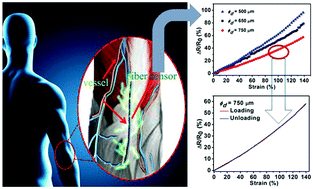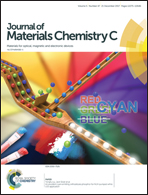Liquid metal fiber composed of a tubular channel as a high-performance strain sensor†
Abstract
Stretchable sensors with high sensitivity, no hysteresis, high conductivity and a fiber conformation have considerable potential application in stretchable electronics, soft robotics and smart clothes—especially, for example, in implantable biomedical fiber-shaped sensors. Herein, inspired by the capability of a vessel organ for sensing temperature variation, the fabrication of a high-performance fiber sensor is reported, comprising a novel superelastic biocompatible fiber composed of a tubular channel injected with low toxicity liquid metal (LM). This study not only reports a highly promising strategy for achieving Young's moduli matching between an inorganic conductor and a soft elastomer, but also provides a novel and facile approach to a strain sensor, learned from the vessel channel structure of higher animals. The sensing mechanism model is verified, and the sensitivity can be regulated by controlling the size of the tubular channel; hysteresis-free characteristics are also reported. The as-prepared LM fiber sensor exhibits close to no hysteresis (0.11%), a low detection limit (0.3% strain), and super-low resistance (0.344 Ω), as well as good repeatability over 3500 cycles. The LM fiber sensor presents huge potential for emerging applications in fields such as stretchable electronics, human motion monitors, and smart clothes, and especially in the development of implantable biomedical fiber-shaped sensors.



 Please wait while we load your content...
Please wait while we load your content...